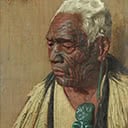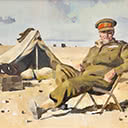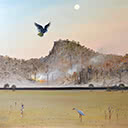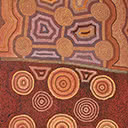General Sir Bernard Freyberg VC
46 x 56 cm
est. $60,000 - 80,000
Provenance:
Dame Kiri Te Kanawa Collection, c. 1990
General Sir Bernard Freyberg VC is one of two uncompleted portraits which McIntyre painted after Freyberg's death. The other work is illustrated p 195, Peter McIntyre War Artist, A H & A W Reed, 1981. McIntyre's first portrait of his commanding officer had been painted during wartime in 1943, see illustration on left.
During the First World War he was awarded numerous honours for gallantry, including a Distinguished Service Order for action in the Gallipoli campaign. Following the out break of World War Two, Freyberg commanded the 2nd New Zealand Expeditionary Force and its fighting arm, the 2nd New Zealand Division, lead their campaigns in Greece, North Africa and Italy. Although criticised for his role in the 1941 fall of Crete, he was a popular figure on the homefront and credited with a sincere concern for the welfare of those under his command. A highly decorated solider, his leadership of the New Zealand Division at the decisive battle at El Alamein marked a major turning point in favour of the allied forces. Freyberg relinquished command of the New Zealand Division in November 1945 having accepted an invitation to become Governor-General of New Zealand, a post he held for six years. On his return to England he frequently sat in the House of Lords and was appointed Lieutenant Governor in charge of Windsor Castle. He died at Windsor in 1963.
Above: Major General Bernard Freyberg maintained a life long interest in the artist's work. Here, Peter McIntyre and General Freyberg enjoy an informal conversation in camp.
In 1939 Peter McIntyre enlisted with the 34th Anti-tank Battery, a New Zealand unit formed in London, and was sent as a gunner to Egypt, where he was reunited with his fellow countrymen after almost nine years. During the war he discovered that his interest in painting did not lie with the avant-garde, but with romantic realism. In Egypt he provided illustrations for the war magazine Parade: as well as creating advertisements he sketched members of the Second New Zealand Expeditionary Force (2NZEF).
In January 1941 McIntyre was appointed as our official war artist and promoted to the rank of Captain by Major General Bernard Freyberg. Between 1941 and 1945 he recorded the activities of 2NZEF in Crete and North Africa, and at Cassino in Italy, where he became a Major. His work was exhibited in Europe and New Zealand and reproduced in magazines such as Illustrated London News , Studio, Parade and New Zealand Listener, making him a household name in New Zealand. His war art defined the New Zealand soldier's experience of the Second World War. Images such as German Parachutists Landing on Galatos, Crete, 28th Maori Battalion Moves Up, and The Wounded at Cassino were subsequently reproduced in numerous publications.
After the war McIntyre returned to New Zealand departing for painting trips to the Antarctic, Hong Kong, the Pacific and the American West. Further travels through the Continent and the East formed the basis of an exhibition that toured the United States for three years.
Early in 1970, Queen Elizabeth awarded the coveted Order of the British Empire to Peter McIntyre for his accomplishments as an author and in the field of fine arts.
Publications include his illustrated autobiography, The Painted Years, Peter McIntyre's West, Peter McIntyre's Pacific, Peter McIntyre's New Zealand, Peter McIntyre's Wellington, Peter McIntyre: War Artist, McIntyre Country and Kakahi.
For more information on this piece, please download this PDF (215KB)





